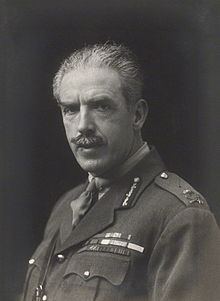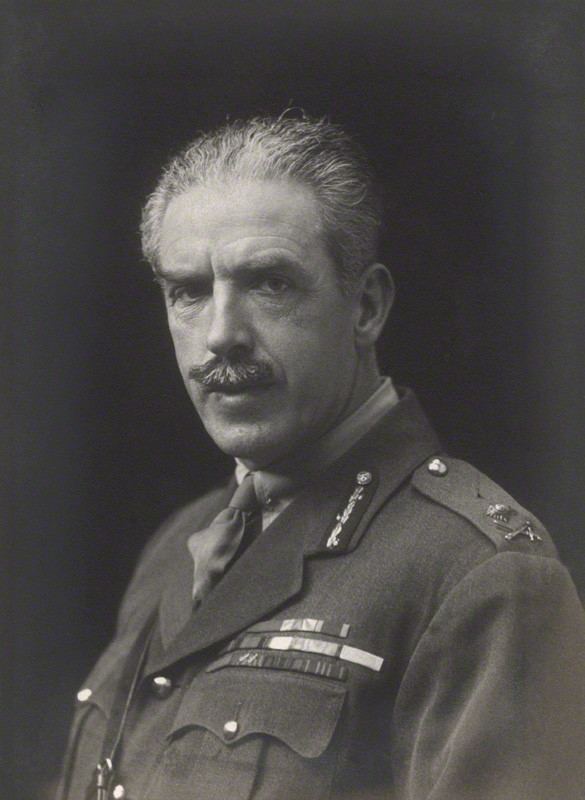Name Tom Bridges Children Alvilde Chaplin Movies The Gang's All Here | Nationality British Education Eton College Role Military officer | |
 | ||
Succeeded by Sir Alexander Hore-Ruthven Full Name George Tom Molesworth Bridges Spouse Janet Florence Menzies (m. 1907) Similar People James Lees‑Milne, Winnaretta Singer, Busby Berkeley, John French - 1st Earl of Yp, James Basevi | ||
Sir George Tom Molesworth Bridges, (20 August 1871 – 26 November 1939) known as Sir Tom Bridges, was a British military officer and Governor of South Australia.
Contents

Bridges had a distinguished military career, seeing service in Africa, India, South Africa, and most notably Europe in the First World War, where he was involved in the first British battle of the war at Mons, and later commanded a division at The Somme and Passchendaele. After the First World War, he served in Greece, Russia, the Balkans and Asia Minor. He was Governor of South Australia from 1922–27.
Early life
Bridges was born at Park Farm, Eltham, Kent, England, to Major Thomas Walker Bridges and Mary Ann Philippi. He was educated at Newton Abbot College and later at the Royal Military Academy, Woolwich. He was married in London on 14 November 1907, to a widow, Janet Florence Marshall; they had one daughter, Alvilde Bridges, who was married first to Anthony Chaplin, 3rd Viscount Chaplin, and then to James Lees-Milne.
Military career
After graduating from the Royal Military Academy, Bridges joined the Royal Artillery as a second lieutenant on 19 February 1892, and soon served in India and Nyasaland (now Malawi). He was promoted to lieutenant on 19 February 1895, and received the rank of captain supernumerary to the establishment on 5 April 1900. Serving in the Second Boer War in South Africa, for a few months in 1901 he commanded two West Australian Mounted infantry contingents. He was mentioned in despatches (including the final despatch by Lord Kitchener dated 23 June 1902). He was confirmed as captain in the Royal Artillery on 8 January 1902, and received a brevet promotion as major on 22 August the same year, while in charge of Guns in a Flying Column serving in Somaliland. In 1908, he became the chief instructor at the Cavalry School at Netheravon. Seeking a more rapid promotion in the army, Bridges transferred to the 4th Queen's Own Hussars in 1909, attaining the rank of major. He was appointed military attaché to the Low Countries and Scandinavia between 1910 and 1914.
Early in World War I, Bridges was involved in the Battle of Mons, where he suffered a shattered cheekbone and concussion. During the British Army's retreat, he met two battalions of exhausted British soldiers at Saint Quentin, whose officers planned to surrender to save the town from bombardment. In a celebrated incident on 27 August, the injured Bridges used a tin whistle and toy drum purchased from a toy shop to rally the men and led them to rejoin General French's army. In October, French flew Bridges to the besieged Belgian city of Antwerp to provide intelligence there for the British headquarters.
He was appointed a Companion of the Order of St Michael and St George in 1915 and given command of the 19th (Western) Division of the New Army, which was demoralised after severe casualties at the Battle of Loos. In 1916 he was promoted to major general. He set about turning the 19th Division into an efficient fighting unit, purging the senior officers. The division was in reserve on the disastrous first day of the Battle of the Somme, and thus avoided serious casualties. It acquitted itself well in the small subsequent attacks around La Boiselle in July.
In 1917, Bridges was sent on the Balfour Mission, military liaison to the United States under Arthur Balfour, soon after the Americans entered the war, to coordinate the sending of American soldiers to Europe. He ran into some difficulty because, like most British generals and politicians, he pushed for the amalgamation or incorporation of Americans into understrength British units to be commanded by British officers. This caused much friction as the American general staff felt that US troops should be commanded by US officers.
Bridges returned in time to lead his division at Passchendaele in 1917. He was severely injured on 20 September at the Battle of the Menin Road Ridge, losing a leg. However he recovered quickly, and after a brief stint as head of the trench warfare department of Churchill's Ministry of Munitions, was sent back to Washington to coordinate the dispatch of American reinforcements to the Western Front. The rate of reinforcements was soon increased threefold.
Subsequently, Bridges was appointed to liaison missions to Greece, the Balkans, and Russia (where he was responsible for the evacuation of the British Mission and the remains of the anti-Bolshevik White Army from Novorossiysk in March 1920). His final active service was in Greece, fighting against the Turks in Asia Minor.
After the war, he was appointed a Knight Commander of the Order of St Michael and St George (1919) and a Knight Commander of the Order of the Bath (1925). His uncle, the Poet Laureate Robert Bridges, also honoured him with an ode To His Excellency.
Governor of South Australia
Bridges was appointed Governor of South Australia in 1922, at the instigation of his friend Winston Churchill. Bridges arrived in Adelaide in December of the same year.
Bridges was a conservative governor, defending capital punishment, supporting the Legislative Council, and denouncing "unemployables". He was also popular with returned servicemen. His speeches were dominated mostly by denouncements of Bolshevism, and promotion of immigration. He was scornful of the Prohibition movement, and created a political storm by addressing a licensed victualler's dinner, entertaining them with G. K. Chesterton drinking songs and other hilarious prohibition stories.
Bridges became frustrated with the Labor ministries of 1924–27. He was particularly angered by Premier John Gunn's publishing of a secret memorandum of a former premier to the governor. When he was offered a second term as governor in 1927 he refused it, and returned to London that year.
Retirement
Bridges devoted his retirement to painting and writing. He published several books:
He had also studied at the Slade School of Fine Art, and was an accomplished painter. He held many one-man exhibitions in Adelaide and London where his oils and watercolours were sold.
He died at 12 Dyke Road, Brighton, on 26 November 1939.
